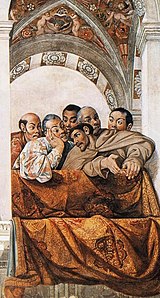Luis Sotelo
| Blessed Luis Sotelo | |
|---|---|
 |
|
| Born | September 6, 1574 ( Seville , Spain ) |
| Deceased | August 25, 1624 ( Ōmura (Nagasaki) , Japan ) |
| beatification | 7th year 1867 by Pope Pius IX. |
Luis Sotelo (born September 6, 1574 in Seville , † August 25, 1624 in Shimabara on Kyushu , Japan ) was a Spanish Franciscan (OFM) .
Life
Sotelo studied at the then famous University of Salamanca before joining the Convent of the Calvario ("Calvary") of the Friars Minor in Salamanca. Sotelo was sent to the Philippines in 1600 to look after the residents of the Japanese settlement of Dilao . However, this was destroyed in 1608 after hard fighting by Spanish forces. Sotelo then went to Japan where he tried to build a church in the Tokyo area . This church was also destroyed after the ban on Christianity in Japan in the area of the Tokugawa shoguns . Sotelo fled to northern Japan, in the area controlled by the Sendai daimyo , Date Masamune , where the Christians were still tolerated.
Sotelo planned and accompanied a Japanese embassy from Date Masamune to Spain in 1614. The embassy was led by Masamune's follower Hasekura Tsunenaga . The captain of the ship San Juan Bautista was Yokozawa Shogen . The embassy was a product of the political ambitions of Sotelo and Date Masamune. Sotelo tried to establish a diocese in northern Japan, which should be independent of the Jesuit- controlled diocese of Funai ( Nagasaki ). The Portuguese hampered his campaign and Sotelo did not even get support from the Franciscans, as the efforts were tied to personal aspirations for the bishopric. Date Masamune, on the other hand, wanted trade relations with New Spain ( Mexico ), but it soon became clear that this trade was too costly.
Sotelo accompanied the Japanese embassy back to the Philippines, where he arrived in 1618 and stayed for some time, as Christianity was already being suppressed by harsh measures in Japan at that time. He ran into problems with the Church because he had exaggerated his achievements in Japan. The Catholic Council of the West Indies sent him back to Mexico in 1620 to continue proselytizing there. In 1622 Sotelo finally managed to sneak into Japan on board a Chinese junk , where he was discovered and arrested. After two years of detention, he suffered a few days before his 50th birthday along with two other Franciscans, a Jesuit and a Dominican , the martyrdom by burning alive. Pope Pius IX beatified Luis Sotelo and his companions in 1867 .
literature
- CR Boxer: The Christian century in Japan 1549-1650 , ISBN 1-85754-035-2
- Claudia von Collani: Luis Sotelo. In: Biographisch-Bibliographisches Kirchenlexikon (BBKL). Volume 10, Bautz, Herzberg 1995, ISBN 3-88309-062-X , Sp. 825-827.
| personal data | |
|---|---|
| SURNAME | Sotelo, Luis |
| BRIEF DESCRIPTION | Spanish Franciscan |
| DATE OF BIRTH | September 6, 1574 |
| PLACE OF BIRTH | Seville |
| DATE OF DEATH | August 25, 1624 |
| Place of death | Shimabara |

